Visual/Allen, Quad VTRs and the Bosch connection
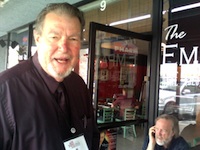
As told by Al Sturm, June 2009 in a series of e-mails to Quad Videotape Group Secretary Ted Langdell
I’ll try to do a chronology of Allen/Visual/Fernseh (Bosch) association from the period of 1965-1970.
Steve Allen was a sharp video entrepreneur who from the early days of Quad was able to come up with accessories to improve the operation of the Quad machines.
Among some of the products were:
A very early manual Amtec. This was a time in electronic state of the art when transistors were first being used in video design.
They built a solid state switcher, and an improved limiter low band demod. This was about the time of the VR-1000B.
Their next project was to replace the tube servo.
Steve had two sharp engineers working with him, Clarence Boice (ex Philco), and Dick Silver (Stanford student) who were the “power behind the throne.” They were very innovative for the time.
Steve had friends at Ampex, and learned of a problem that it was difficult to obtain quality variable delay lines for Amtecs. It was very difficult matching the varicaps and holding tolerance on the wound inductors. They then started building and selling them to Ampex.
They also built balanced output filters for the VR-1000C demod, which Ampex used.
Simultaneously, Visual Electronics was a primarily a rep company for broadcast TV equipment.
Jim Tharpe—Visual’s president—was involved in TV all the way back to the DuMont days.
One of his coups was to become the sole US importer for the Philips Plumbicon cameras. This was about the time when color hit so they were the “only show in town.” Among products Visual sold were the accessories from Allen Electronics.
In 1964 when the VR-2000 was introduced. High Band became the standard for broadcasters.
Jim Tharpe was intrigued with Allen and thought they could build a competing high band system due to their experience with signal systems. He then bought Steve Allen out.
The problem turned out to much harder to solve than Visual was led to believe. Among the problems were:
Number 1: Understanding Charlie Ginsburg’s high band patent, and
Number 2. Designing a high band signal system that didn’t infringe the Ampex patent.
Along with Clarence Boice and Steve Allen, Visual brought in engineers from France, Germany, and New York to solve the problems.
This is when I went to work for Visual because of my field engineering background with Ampex. My job title was “Jack of all trades” trying to be a go between with Visual, Allen, and customers. I ended up being somewhat of a “fire fighter”.
They had some success. As a result Visual put together a VTR using the VR-1000 console and monitor rack with a solid state H-locked servo, signal system utilizing the MK10 head, Amtec, and Colortec.
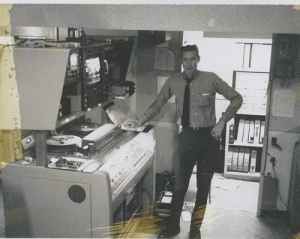
That’s me with my “AJ squared away” crew cut.
Because of the buyout of all the Ampex equipment, Ampex wasn’t too concerned with the competition.
A number of the “Allenized” machines were sold by Visual Electronics.
Some customers were: Corinthian Broadcasting (then a subsidiary of Dun and Bradstreet,) NBC New York for their time delay, and a number of educational and religious broadcasters.
(Quad Videotape Group Secretary Ted Langdell notes that in 1977, an Allenized VR-1000 was still in use at Corinthinan’s KXTV, 10, Sacramento, often recording the first feed of CBS Evening News with Walter Cronkite for “cherry-picking” stories, and other feed duties.)
The Visual/Allen machine at KXTV was from a purchase made by George Jacobs, Director of Engineering for the Corinthian stations. KOTV Tulsa was another. The president of Visual Electronics Jim Tharpe and George were good friend from their past DuMont days.
The next step by Visual was to build their own VTR.
Tharpe had contacts in Germany with Fernseh who had a monochrome VTR with their own air bearing heads.
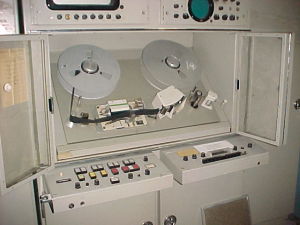
An association was formed between Fernseh and Visual.
Fernseh supplied frame, transport, and heads to Visual who built a high band signal system, motor controls, and servo from the Allen electronics to compete with Ampex.
I was in Darmstadt, Germany many times during the development and know quite a bit about their products.
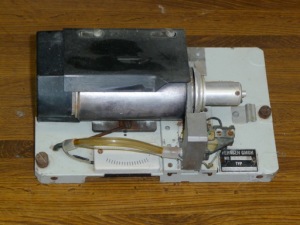
The Fernsh head was very good. It had some good features, one of which was linear bearings for the guide.
It was very repeatable and positive.
Visual then made and marketed a machine called the VA50.
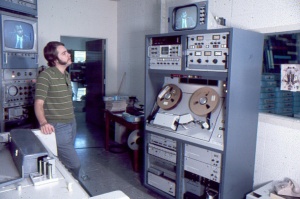
The VA-50 was a striped down version of the VA-100.
I frankly can’t remember what was left off.
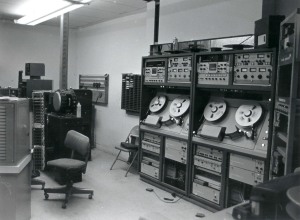
It had limited success.
The problem was with all the design engineering, field engineering, and buyout items from Ampex and Fernseh costs, profit margins were very slim.
Pricing was around $45,000.00 for the VA-50 and $55,000.00 for the VA-100.
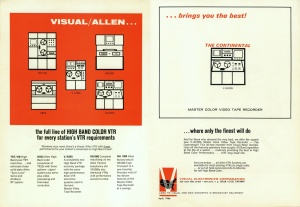
Visual was having other financial problems so they shut the VTR project down.
This is when John Streets and I started Merlin (Merlin Engineering Works) by buying out all the excess inventory from Visual.
We then started refurbishing and reselling VR-2000’s , VR-1200’s, building our own high band signal system and offered high band kits for older machines.
This is the story to the best of my recollection.
Al Sturm
Sturm passed away April 22, 2013 at his home in San Jose, California. Al was 78, and had been working on a new TBC project until shortly before his passing.
TL notes that Visual/Allen’s 1966 catalog advised that it could convert RCA TRT series tube-type machines to all solid-state high band/all band versions, and could do the same for RCA’s TR-22 solid state machines, which were initially low-band only when introduced before Ampex introduced high band in 1964.
It rebuilt Ampex’s tube-based VR-1000s as transistorized High Band units, and used the VR-1000 transport in a new housing to offer most of the high-end features offered by uThe Visual/Allen 100G “Master Color Video Tape Recorder.”
